In January the first maps of Comet 67P/Churyumov-Gerasimenko were published, identifying 19 geomorphologically distinct regions on its surface. Six months on and much more work has been done on refining the boundaries between these regions. This blog post showcases some of the OSIRIS images acquired from close orbit and presented in a new paper that have enabled an in-depth study of the different regions and their boundaries. This post was prepared with inputs from lead author M. Ramy El-Maarry from the University of Bern, who introduces this post with an inside story on how some of the regional names were chosen:
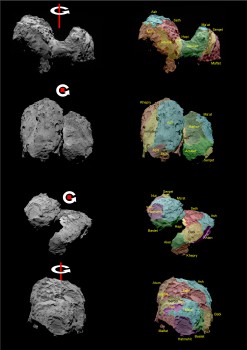
OSIRIS images showing Comet 67P/Churyumov–Gerasimenko in different orientations. Rotation axes have been added; in the middle two panels the rotation axis is almost toward the viewer, that is, providing a north polar view.
Right: the same images with regional boundaries and nomenclature added.
Credits: ESA/Rosetta/MPS for OSIRIS Team MPS/UPD/LAM/IAA/SSO/INTA/UPM/DASP/IDA
“Early on in the mapping phase, we decided on naming the regions of the comet using names of ancient Egyptian deities. We wanted to adhere to the ancient Egyptian theme of the mission and have a large inventory of names if needed. Luckily, ancient Egyptians had so many deities in their long history that made this an easy decision. Moreover, many of the names were catchy, easy to remember, and more importantly, easy to pronounce. I remember we initially tried using names of ancient cities and we were coming across a lot of names that were very difficult to wrap your tongue around, even for an Egyptian like me! So we decided to use the following naming convention: gods for the ‘body’ lobe and goddesses for the ‘head’. We picked Hapi for the neck since Hapi is the Nile god, and we figured that he should separate the lobes in the same way that the Nile splits Egypt into an eastern and western side. Of course, there were obvious names to discard (such as Osiris!) so we decided to skip on all ‘world-famous’ gods such as R’a and Amun, partly because they have been used before in other missions, but also to introduce people to lesser-known names.
In another story, we decided on using Imhotep for one of the most notable regions on the comet. Imhotep was one of the most brilliant figures of the ancient world as a scientist, engineer, and a physician. Luckily for us, there were no Nobel prizes in ancient Egypt, so when Imhotep died, he was deified by ancient Egyptians to credit his accomplishments, which meant we could actually use his name as a nice tribute from our side!”
Around Aten, Aker, Babi and Khepry
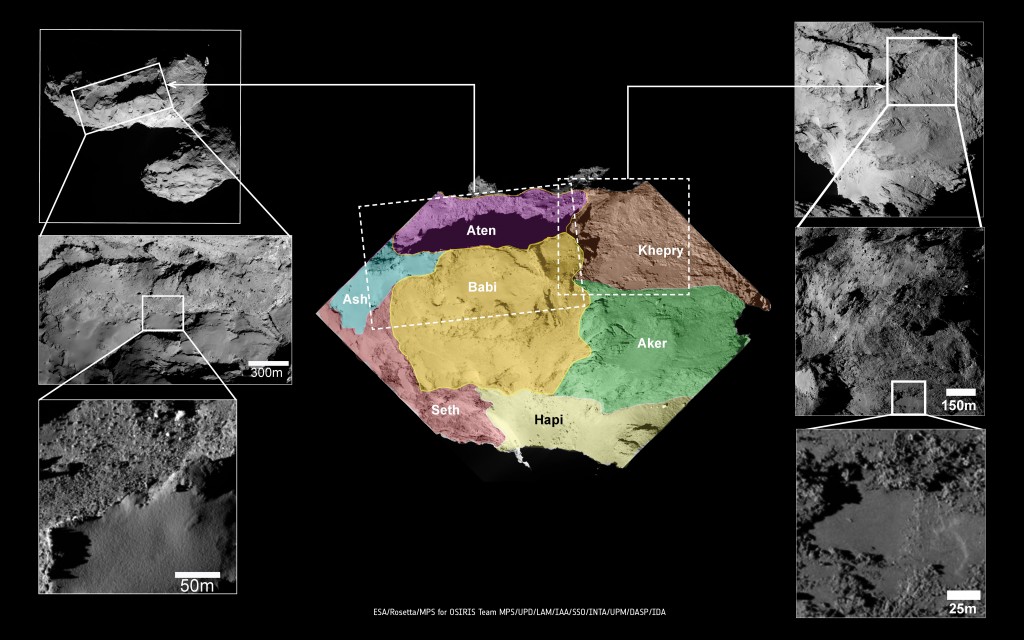 This set of images focuses on a number of boundaries on the comet’s large lobe, in particular on the smaller regions Aten, Aker, Babi and Khepry, their relationship to each other and to the larger and perhaps more familiar Seth and Ash regions nearby. The transition into the smooth Hapi neck region is also indicated in the context image. The insets show interesting contrasts in surface textures at the boundaries of Aten and Babi (left) and Khepry, Babi and Aker (right).
This set of images focuses on a number of boundaries on the comet’s large lobe, in particular on the smaller regions Aten, Aker, Babi and Khepry, their relationship to each other and to the larger and perhaps more familiar Seth and Ash regions nearby. The transition into the smooth Hapi neck region is also indicated in the context image. The insets show interesting contrasts in surface textures at the boundaries of Aten and Babi (left) and Khepry, Babi and Aker (right).
Aten is dominated by a large elongate depression surrounded by the brittle and dusty material of Ash and Babi. El-Maarry et al suggest that its sharp sides and irregular shape could point to a rapid and perhaps violent burst of activity. The close-ups show rubble and boulders inside the depression, the largest of which reach up to 30m in diameter. The rubble suggests rock fall events, most likely from the rim of the depression.
The smooth deposits on the surrounds make a striking contrast and mark the boundary with Babi. In the middle inset (left) this dusty covering can be seen overlying regions of significant layering, which could be parts of Seth extending below the dusty deposits of Ash and into Babi. Indeed, Babi hosts one quasi-circular structure reminiscent of Seth that rises 60-80m over Khepry, marking the boundary in this area (see insets at top and middle right). Well-defined ridges also separate the lower-lying Babi from Aker and Seth.
Khepry and Aker both have a rough, consolidated appearance, exhibit linear markings but very few boulders. Aker has a slightly smoother surface texture than Khepry but they both contain very smooth patches 50–100m across that are located in topographical lows. The inset at bottom right shows a close-up view of one of these smooth deposits close to the Khepry-Aker border.
From Anubis and Atum to Hapi and Anuket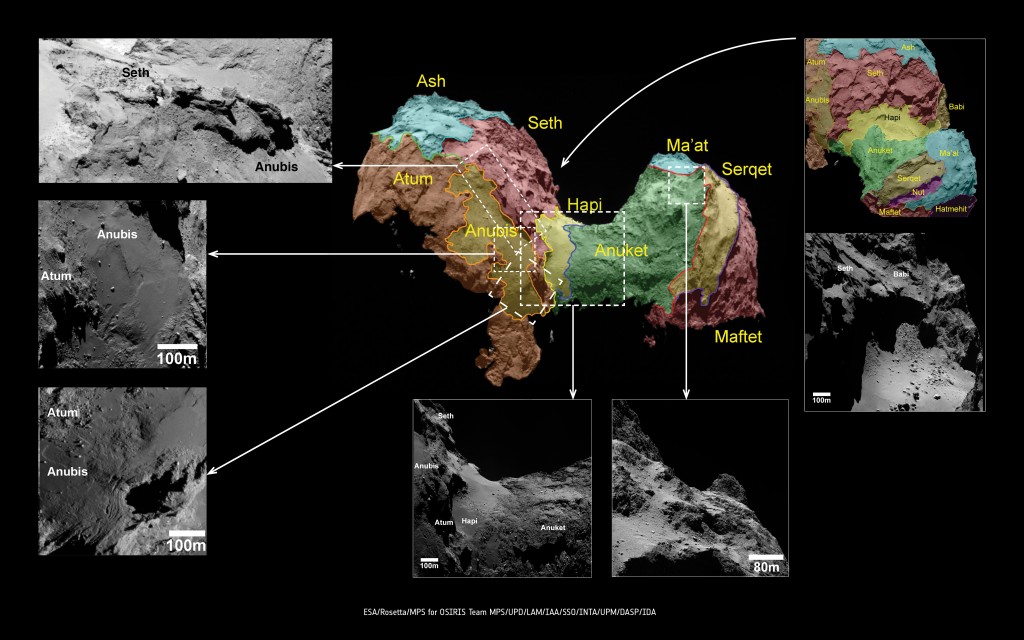 This image set highlights the boundaries between Anubis, Atum and Seth on the large lobe, and the transition between the neck and Anuket on the small lobe.
This image set highlights the boundaries between Anubis, Atum and Seth on the large lobe, and the transition between the neck and Anuket on the small lobe.
Atum is a rather complex, rough-textured region with linear features that are similar to some of the structures observed in Imhotep and interpreted as terraces resulting from erosion of an underlying layered terrain. Atum borders the smooth-textured Anubis region and almost encloses it, with a well-defined ridge separating it from Seth.
A notable feature between the boundary of Anubis with Atum is a set of parallel curved lineaments. This feature could indicate possible folding of the surface, or the surface expression of buried terraces.
Nearby, Atum shares a boundary with the Anuket region on the head lobe, the latter of which appears to traverse the neck region in an area devoid of the smooth deposits that define the transitional Hapi region.
Anuket has a rough surface with numerous boulders but appears to smooth out away from the neck and toward the boundary with dust-covered Ma’at. The smoother regions seen in Anuket are patches of dust, suggesting that material similar to that of Anuket’s surface may extend underneath the dust-covered Ma’at region.
On the head: Ma’at, Maftet, Nut and Serqet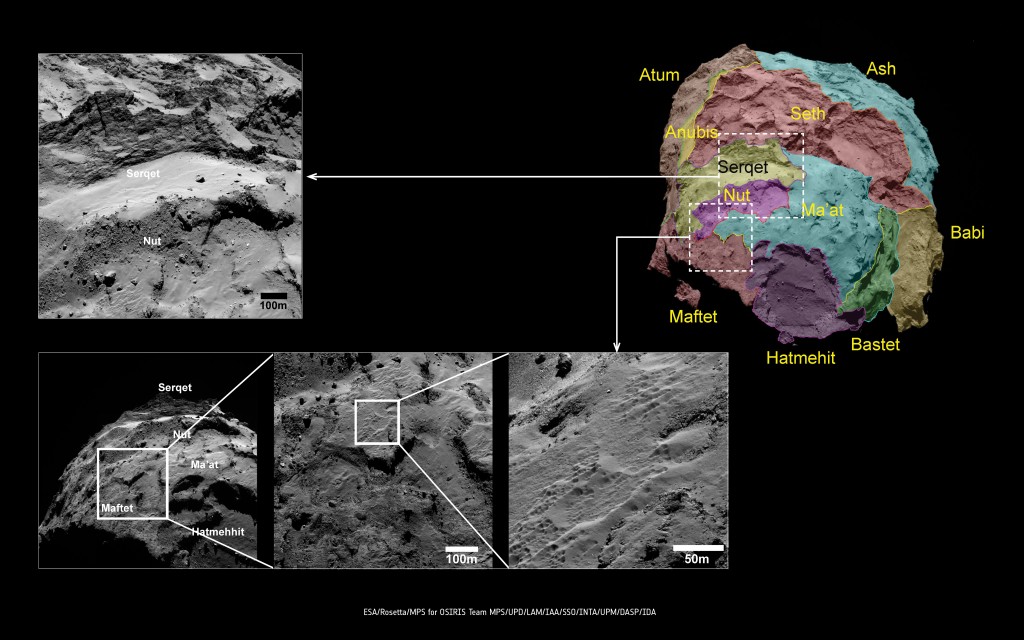 The Nut depression and Serqet are two of the smallest regions on the surface of the comet in terms of surface area, but yet show significant morphological diversity. The Serqet region is defined by a ridge of consolidated material with an adjacent flat and smooth, dusty plain, which forms the rim of Nut. Nut is classified as a depression and is extensively infilled with boulders, perhaps from the erosion of Serqet and an influx of dust similar to that seen in Ma’at.
The Nut depression and Serqet are two of the smallest regions on the surface of the comet in terms of surface area, but yet show significant morphological diversity. The Serqet region is defined by a ridge of consolidated material with an adjacent flat and smooth, dusty plain, which forms the rim of Nut. Nut is classified as a depression and is extensively infilled with boulders, perhaps from the erosion of Serqet and an influx of dust similar to that seen in Ma’at.
Ma’at’s dust-covered texture resembles Ash on the comet’s body. It also exhibits sharp outcrops of materials emerging from the dust, which show similarities to the more consolidated material in Anuket. Ma’at grades into Maftet where the dust gradually thins out into rough, terraced and fractured terrain pockmarked with irregularly shaped shallow depressions. Patches of the fading dusty material along this boundary show a pitted texture, which El-Maarry et al suggest is an ice-rich material that may be undergoing desiccation through sublimation. The dust covered regions both on the head and on the body of the comet are likely linked to ‘airfall’ deposition from more active regions.
Explore the comet in 3D
Further details of the comet’s boundaries are provided in stunning anaglyph images that are possible when two images of similar spatial resolution and illumination are taken of the same region and can be appropriately co-registered. The following anaglyphs were used to identify and assess topographical boundaries between adjacent regions and changes in relief in the latest study. To best enjoy the 3D effect, please use red-blue/green “3D” glasses.
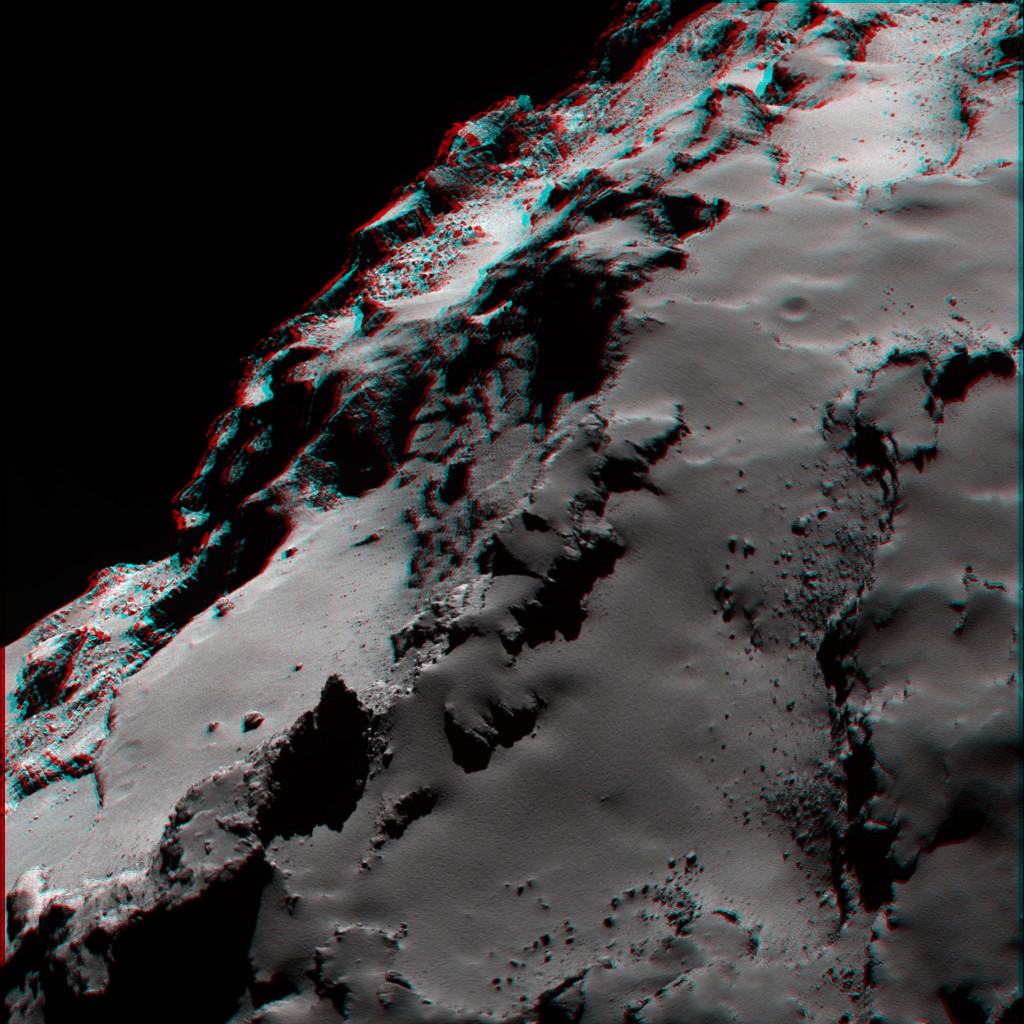
OSIRIS narrow-angle camera image showing the smooth nature of the dust covering the Ash region and highlighting the contrast with the more brittle material exposed underneath in Seth.
Credits: ESA/Rosetta/MPS for OSIRIS Team MPS/UPD/LAM/IAA/SSO/INTA/UPM/DASP/IDA
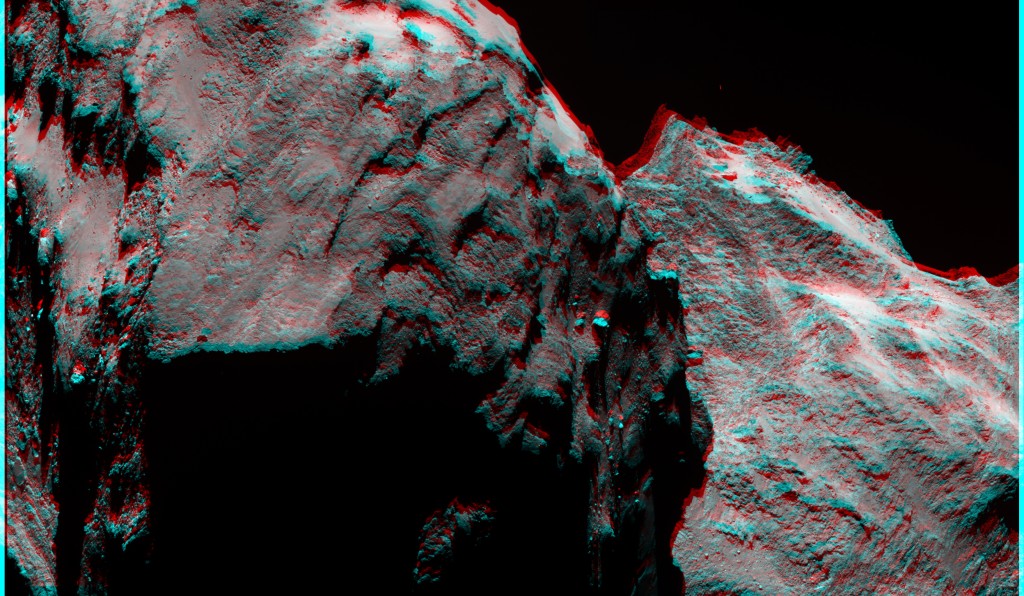
OSIRIS narrow-angle camera mosaic of two images showing an oblique view of the Atum region and its contact with Apis, the flat region in the foreground. This region is rough and pitted, with very few boulders.
Credits: ESA/Rosetta/MPS for OSIRIS Team MPS/UPD/LAM/IAA/SSO/INTA/UPM/DASP/IDA
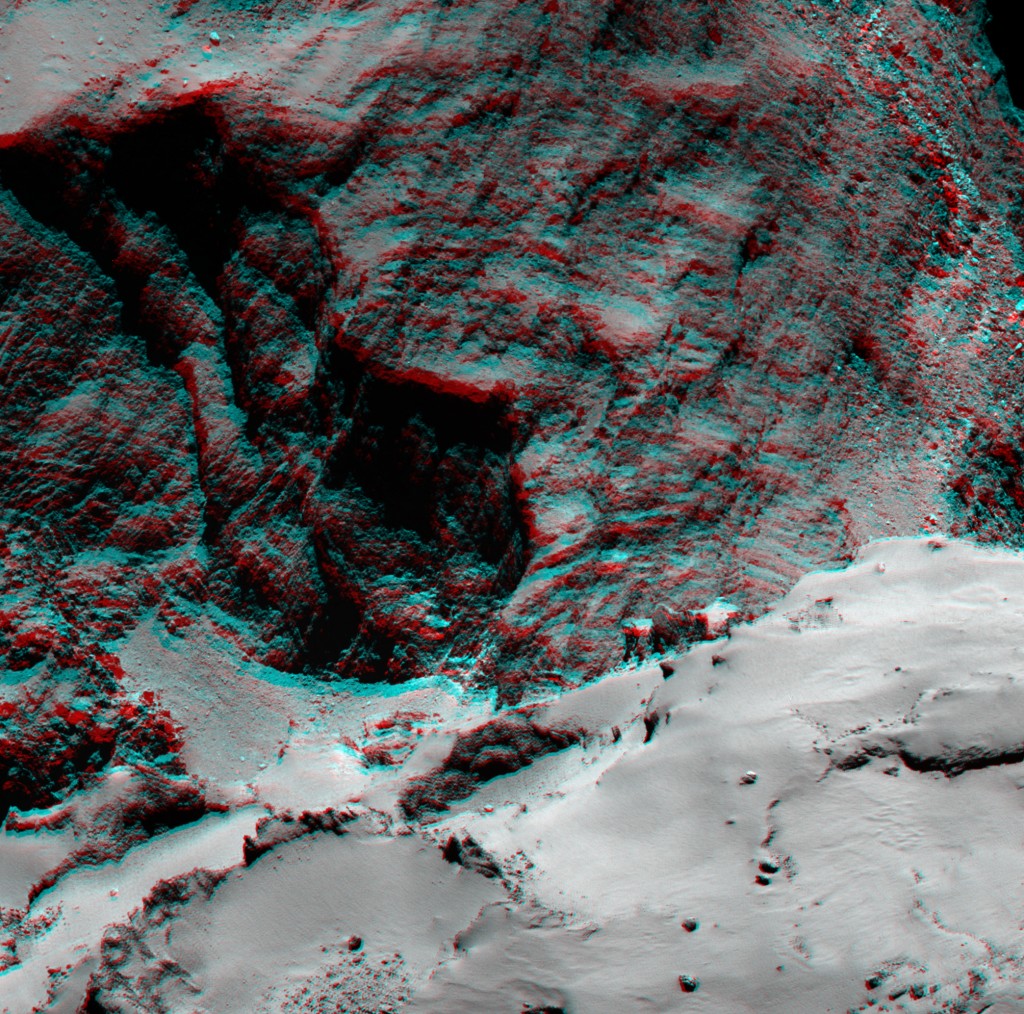
OSIRIS narrow-angle camera image highlighting an alcove structure at the Hathor-Anuket boundary on the comet’s small lobe. The layering seen in the alcove could be indicative of the internal structure of the comet.
Credits: ESA/Rosetta/MPS for OSIRIS Team MPS/UPD/LAM/IAA/SSO/INTA/UPM/DASP/IDA
Non-anaglyph versions of these images, along with individual images of the insets seen in the context images in this post, are available via the ESA web portal gallery.
“Regional surface morphology of comet 67P/Churyumov-Gerasimenko from Rosetta/OSIRIS images” by M. R. El-Maarry et al is accepted for publication in Astronomy & Astrophysics.









Discussion: 14 comments
Greetings!
First, thanks for the terrific Web site. I thought the animation of Rosetta’s trajectory was fascinating. And to be honest – the real trajectory of the mission is truly an IMPRESSIVE achievement. Congratulations!
I was hoping you would comment more about the materials in the Comet. I tend to think of comets as containing frozen gases. I am very surprised to see an object that looks like stone and dust (or stone and ash). Is this a “dead comet” – all volatile matter has escaped and what we are seeing is a stone core? Do you believe that any metal could also exist inside the comet’s structure? Are there density estimates?
Big thanks!!
Hi Pete
Pleased you’re enjoying the website.
It’s hard to see the comet’s activity in these close images but from much further away (also with different exposures) you can see it quite clearly – see this image taken last week for example: blogs.esa.int/rosetta/2015/07/15/cometwatch-7-july/
For the density then it’s 470kg/m^3, pointing to a highly porous mix of dust and ices. You can read more about the basic parameters in this article: https://www.esa.int/Our_Activities/Space_Science/Rosetta/Getting_to_know_Rosetta_s_comet
Best wishes
Emily
Awesome pictures, if you have more 3D pictures of the comet dont be shy to show them to us.
Great work.
Stunning pictures and an informative text,thank you.Good work!
The photo at bottom right of the Anuket and Hapi set has been misidentified in that it is assumed to be showing the two obvious Serqet head rim protrusions. In fact, it’s showing the biggest one (the triangle) plus the biggest boulder protrusion in the neck below it. It shows no part of Ma’at or the other obvious head rim protrusion that borders Ma’at. This means the orientation square needs to be shunted vertically down by 3/4 of a square length to catch the dark green spear shape (the boulder) and cut out the blue depicting Ma’at. This is important because correct identification of the rim triangle allows hi res matching of that wavy rim, lined with squares, to the wavy perimeter lined with squares on the body below.
Here are selected quotes from the post with my thoughts after ‘///’.
“Aten is dominated by a large elongate depression surrounded by the brittle and dusty material of Ash and Babi. El-Maarry et al suggest that its sharp sides and irregular shape could point to a rapid and perhaps violent burst of activity.”
///The violent burst of activity was quite likely to have been due to Aten being the site of a missing slab due to comet spin-up and fragmentation. This would class Aten along with Imhotep, Hatmehit and Anubis which are also named as separate regions without the realisation that these are residual craters or trays left by missing slabs.
“Aker has a slightly smoother surface texture than Khepry but they both contain very smooth patches 50–100m across that are located in topographical lows.”
///Aten is one of the least disturbed parts of the comet due to being near but not on the hinge on which the head tipped up.
“Atum is a rather complex, rough-textured region with linear features that are similar to some of the structures observed in Imhotep and interpreted as terraces resulting from erosion of an underlying layered terrain.”
///As with Aten, the only erosion is the one-off departure of an entire slab
“Atum borders the smooth-textured Anubis region and almost encloses it, with a well-defined ridge separating it from Seth.”
This statement is almost defining the entire tray perimeter left by the missing Anubis slab. The well-defined ridge separating it from Seth is most likely due to a sudden shearing event along this exact line (which would have happened at the same time as shearing along an identical straight line along the other side of the long triangle of craters). The sudden shear happened when the head lobe broke away from the body.
“Anuket has a rough surface with numerous boulders but appears to smooth out away from the neck and toward the boundary with dust-covered Ma’at. The smoother regions seen in Anuket are patches of dust, suggesting that material similar to that of Anuket’s surface may extend underneath the dust-covered Ma’at region.”
///This dustier area came from the front of the ‘scalped’ area next to the triangle of craters. It doesn’t have anything to do with the typical texture of Anuket which was extruded from the Hapi region to form the neck (because boulders at the top of the neck can be matched to the body).
“The Nut depression…”
///This is actually a ledge which betrays the width of the structure that has the ‘vertical’ dust covered plain below it. This entire structure held firm till the last moment, pinning down the back of the head lobe to the body. The reason for the apparent depression is that the stratum above it slid forward under the spin-up force while the vertical plain held firm.
“Serqet region is defined by a ridge of consolidated material”.
///This ridge isn’t consolidated at all. The triangle on this part of the rim and its similar counterparts are just about the most stretched parts of the comet.
“Nut is classified as a depression and is extensively infilled with boulders, perhaps from the erosion of Serqet”.
///These boulders are sitting on the ledge which is the most ‘horizontal’ component on the slope from Serqet to Hatmehit. In fact, the distribution of boulders in this general area appears to be intimately related to the angle of the surface. Those surfaces that are more radial than circumferential (i.e. sticking up more) to the rotation direction appear to be being favoured. Nut sticks up the most. This means it caught the most rocks as they floated down the rotation plane in suborbital trajectories as collateral debris on the departure of the Hatmehit slab.
“Patches of the fading dusty material along this boundary show a pitted texture, which El-Maarry et al suggest is an ice-rich material that may be undergoing desiccation through sublimation.”
This area of Maftet is in effect an area of Ma’at that experienced collateral damage when nearly a quarter of the head lobe was sliced off during the head-tip and stretch. The slice is across the s pole side and very obvious. Inevitably some strata along the edge of the slice were unceremoniously yanked of the sloping top of the head lobe- which has now been named Maftet because it looks different there. Its appearance has very little to to with extra ices or sublimation even if somewhat more ice happened to be exposed as a result of having the thin, delicate top layers ripped away. This collateral damage is the reason there’s such a gradual change in appearance from Ma’at to Maftet- morphologically speaking, it’s all Maftet, some untouched, some roughed up along the edge of the slice.
All the above is dealt with in Parts 20-26 on the stretch theory blog (26 out next week).
Hi,
About the insets, these are clearly just approximate locations, several of which are taken from figures in the paper. But, because some of the context images are at different orientations to the images themselves, then some small discrepancies may occur due to differences in viewing angles. Hope it still gives you the general idea.
Hi Andrew,
Having a good read of your comment and essentially peer reviewing it 🙂 I think the following snippet has a typo or more likely autocorrect fail. The quote was referencing Aker, and I believe you meant to say Aker was near the hinge…
“Aker has a slightly smoother surface texture than Khepry but they both contain very smooth patches 50–100m across that are located in topographical lows.”
///Aten is one of the least disturbed parts of the comet due to being near but not on the hinge on which the head tipped up.
The take home message is that slab removal explains a lot of the morphological surface differences, and the related debris fields of boulders is explained from the collateral surface fractures in those removals. The photographic evidence couldn’t be more clear.
Marco
Thanks! Yes, I meant Aker, not Aten.
Yes , interesting, boundaries all over the surface between regions of different characteristics. But there are other more significant boundaries that have received little attention. The boundary at the surface of the nucleus, where all the activity is, between the surface and the immediate surrounding environment. The boundary between the edge of a jet and the background coma. The boundary between the edge of the coma and the heliosphere. And the boundary between the surface hdrocarbon and dust layer and the hypothesised underlying ice. Let us hope they will all feature in due course.
@originaljohn
“Hypothesised underlying ice”
So what was the “hypothesised underlying ice” that indisputably rocketed out of Tempel 1, 10 years ago? A figment of the imagination?
Saw it, been there, done that. That is why your lord and master, Thornhill, came up with a silly story about it. Realised that it kicked his neo-Velikovskian nonsense into touch. Had to rescue it. DVD and book sales, not to mention his income from this crankery, would fall horrendously.
Double flash? Nobody else saw it. Massive electric discharge? Not seen. SWIFT data confirms that.
If you want to continue believing in a faith based delusion, that is fine; we give certain leeway to people who believe in faith based beliefs. Until, that is, they try to pass them off as science.
What you believe has as much to do with science as astrology or homeopathy. And has the same amount of evidence. That is……zero.
Could you provide 3D pictures of the comet in .MPO format? Then I could use my 3D TV set to look at them.
Thanks for the fantastic coverage of the Rosetta mission
Gerd
A great post, Emily, and what a wonderful paper, with FREE ACCESS by El-Maarry, et al, as listed at the end of your post:
https://dx.doi.org/10.1051/0004-6361/201525723
AND for those of us who don’t use the two-color stereo anaglyphs, here is my “How to Deconstruct an Anaglyph” into stereo components:
https://univ.smugmug.com/Sample-Gallery/i-987z2QF/0/L/Anaglyph_deconstruct-L.png
Here is a recap of the method from a earlier Blog Post:
“It’s not hard to “deconstruct:” an anaglyph. Put it in an image editor (“Photoshop” or the like) and Split it into it’s individual R, G and B images, You’ll end up with three grayscale images. The Red grayscale image is the Left Eye “channel”, the Green and Blue images are identical (G&B make the cyan channel of the anaglyph) so discard one of the pair, and that Blue image makes the Right channel of the stereo pair.
You end up with two grayscale images that can be used as crosseyed or straight-eyed stereo or in a stereoscope or stereo viewer. The advantage is that the pair is already aligned perfectly.”
Thanks,
–Bill
Great! Always enjoying NASA’s 3D images.
The anaglyphs look fantastic. The sense of shape and depth of the pits and depressions, really shows how they were once spherical voids or bubbles. All the little inset pictures give a great overview of all the different terrains too. Lots and lots of great images to peruse.
Many, many thanks to all those involved. What an awe inspiring achievement this mission is turning out to be.